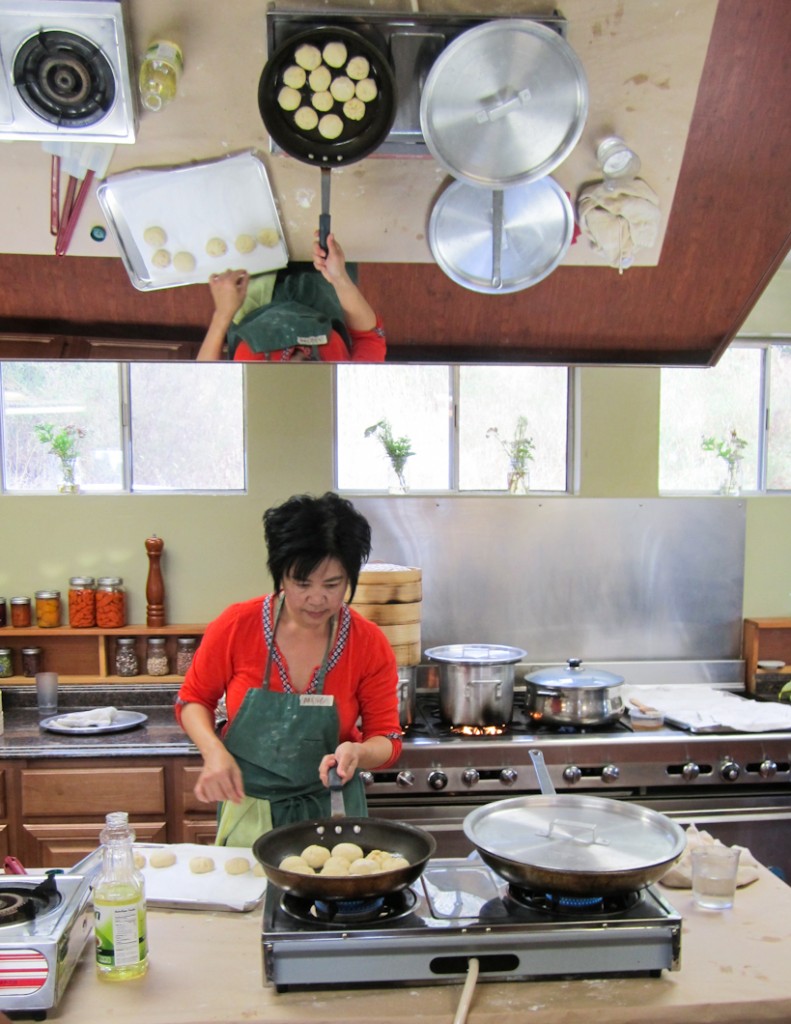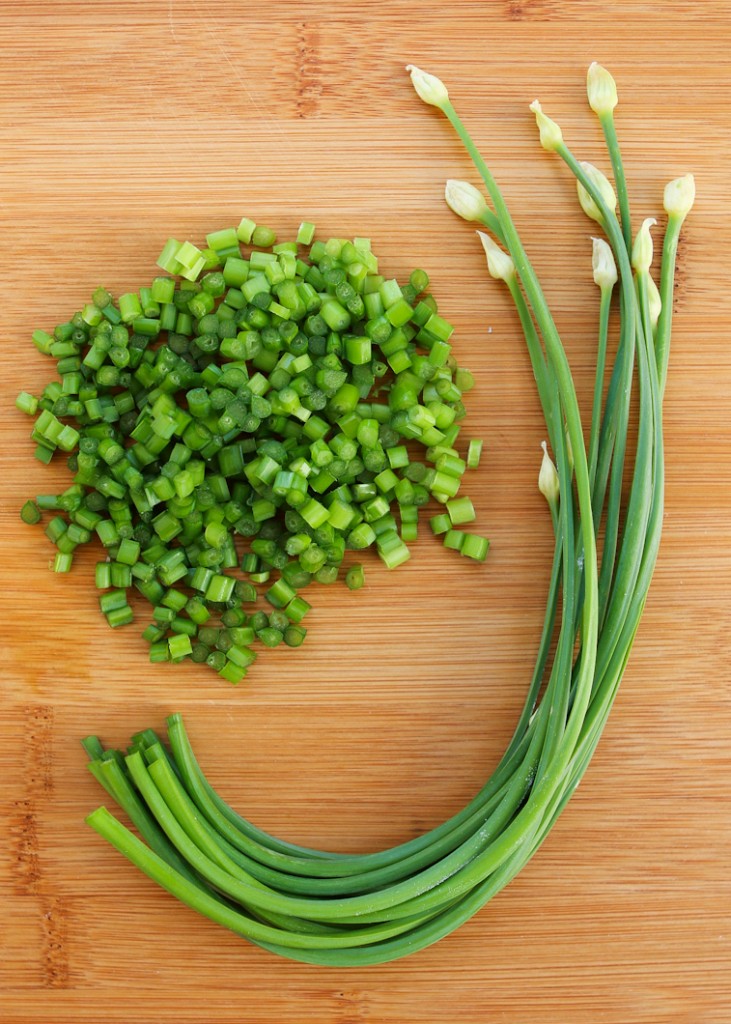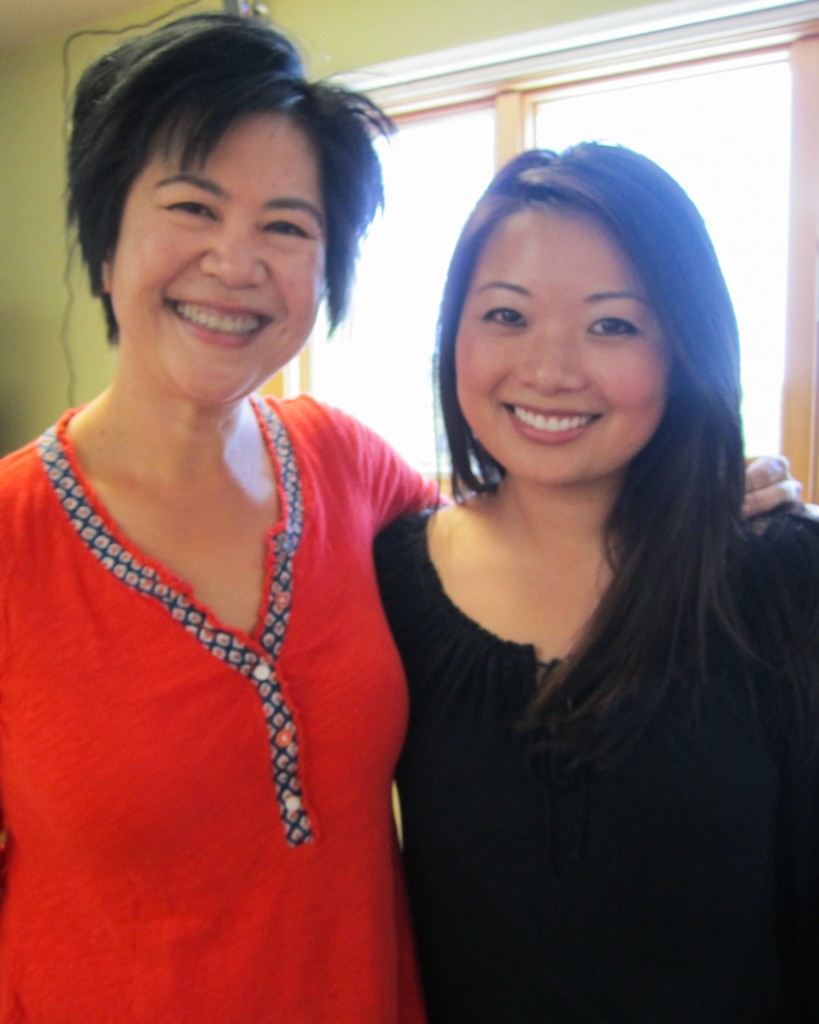 At Love Apple Farms in Santa Cruz this past weekend, I met one of my culinary idols, Andrea Nguyen. If you aren’t familiar, Andrea is the author of several Vietnamese cookbooks, including Into the Vietnamese Kitchen, Asian Dumplings (my favorite), and her most recent release, The Banh Mi Handbook.
At Love Apple Farms in Santa Cruz this past weekend, I met one of my culinary idols, Andrea Nguyen. If you aren’t familiar, Andrea is the author of several Vietnamese cookbooks, including Into the Vietnamese Kitchen, Asian Dumplings (my favorite), and her most recent release, The Banh Mi Handbook.
I’m always trying to improve my dumpling making skills because I consider dumplings to be quintessential Asian tea food. Dumplings are to Asian tea culture what finger sandwiches are to English tea culture. Elegant, flavorful, and beautifully presented, they make any culinary tea experience unforgettable and exquisite.
Earlier this year, I posted a recipe for Ha Gao, those translucent little shrimp dumplings that you find at dim sum houses. Interested in learning how to make Ha Gao the authentic way, with real fatback, (my Ha Gao are a slimed down version of the real deal) I parked myself at the Ha Gao table with Uwe, who ended up being my cooking partner for the day. I also wanted to see if I could try at improving my pleating skills, since I always end up skipping over this intricate part of dumpling making.
 Uwe (who’s actually from Germany!) was in charge of all the chopping and seasonings for the Ha Gao filling while I landed with the task of shelling and deveining way too many shrimp. It took awhile, but I think we did a pretty decent job following the instructions to form a textured yet homogenous filling.
Uwe (who’s actually from Germany!) was in charge of all the chopping and seasonings for the Ha Gao filling while I landed with the task of shelling and deveining way too many shrimp. It took awhile, but I think we did a pretty decent job following the instructions to form a textured yet homogenous filling.
 When you get the chance to see Andrea Nguyen in action, it starts to make perfect sense why she’s been nominated for a countless number of culinary awards, including the prestigious James Beard Foundation Award. She’s exceptionally clear and detailed with her instruction. Here, you see her standing with her back to the classroom so that we can see how to wrap dumplings from the dumpling wrapper’s vantage point (i.e. meaning the person wrapping the dumpling).
When you get the chance to see Andrea Nguyen in action, it starts to make perfect sense why she’s been nominated for a countless number of culinary awards, including the prestigious James Beard Foundation Award. She’s exceptionally clear and detailed with her instruction. Here, you see her standing with her back to the classroom so that we can see how to wrap dumplings from the dumpling wrapper’s vantage point (i.e. meaning the person wrapping the dumpling).
Below you can check out a few of the artful dumplings that Andrea wrapped. When students in the class remarked how perfect her dumplings turned out, she warmly responded: “Do you know how many times I’ve done this!?” I love that someone as successful as she is can be so humble and down-to-earth.
Here I am, eating, while others are still hard at work cooking away. When the hot dumplings started getting dished out, everyone honed in on them like a pack of ravenous wolves. Seriously, you can’t blame us…I mean just look at them! You can tell from the photo below this one that I wasn’t the only greedy person in the class that day…what can I say–a freshly cooked dumpling just has that kind of effect on people!
 At the end of the 4-hour class, the results were simply gorgeous. Even now, looking at all these artistic, flavorful little pockets of goodness fills me with pure joy. Steamed, pan-fried, baked…I think we pretty much covered them all!
At the end of the 4-hour class, the results were simply gorgeous. Even now, looking at all these artistic, flavorful little pockets of goodness fills me with pure joy. Steamed, pan-fried, baked…I think we pretty much covered them all!
 Andrea Nguyen’s cookbook, Asian Dumplings, is truly a masterpiece. If you are looking to learn more about shaping, pleating, filling, and cooking these delicacies, you simply must check the book out! Filled with helpful diagrams and beautiful food photos, it’s a comprehensive dumpling encyclopedia of sorts.
Andrea Nguyen’s cookbook, Asian Dumplings, is truly a masterpiece. If you are looking to learn more about shaping, pleating, filling, and cooking these delicacies, you simply must check the book out! Filled with helpful diagrams and beautiful food photos, it’s a comprehensive dumpling encyclopedia of sorts.
Even better yet, if you end up wanting to ask Andrea a question in person you can sign up for her classes at Love Apple Farms in Santa Cruz. You’ll leave class with a head full of knowledge and a tummy full of delicious dumplings…in my book, it really can’t get any better than that!
***Tips for Making Asian Dumplings***
Now here’s a list of tips I’ve gathered not only from my dumpling class this past weekend, but also from my trials and errors in dumpling making over last few years. Practice makes perfect, but at the end of the day, it’s good to know that any wonky looking dumplings will taste just as great as the ones that look pretty. That being said, here are a few ideas on how to make your dumplings look as good as they taste.
Dumpling Tip #1: Store-Bought First.
There is nothing wrong with using store-bought wrappers. Store-bought wrappers are an excellent way to perfect your pleating and folding skills until you graduate to making homemade dumpling wrappers. They are also time-effiecient and work great with a variety of fillings and cooking methods.
Dumpling Tip #2: Dry it Good.
Just like you do with a salad, take your veggies for a spin in a salad spinner before adding them into a dumpling filling. Ideally, your filling should be moist but definitely not runny. Runny fillings are a headache to control, especially when spooning them onto the prepared dumpling skins. Excess moisture can make it difficult to seal the dumplings tightly.
Dumpling Tip #3: Chop it Fine.
Many vegetables have the tendency to be bulky and rigid, so you want to take the time to cut them finely. This will prevent them from poking or tearing through the soft dumpling skins. Veggies like napa cabbage should be chopped, salted, drained, and dried before adding them to a filling. This wilting process will help the cabbage soften and meld well with other soft ingredients like chopped mushrooms, tofu, or ground meat. You don’t have to salt thin veggies like chives because they aren’t very bulky, especially when you’ve taken the time to chop them into a fine mince.
Dumpling Tip #4: Get the Right Tools.
An Asian-style rolling-pin is essential for making homemade dumpling wrappers. Unlike Western-style rolling pins, Asian rolling pins are lighter, thinner, and easier to maneuver. If you are really serious about dumpling making, you’ll also want to get a tortilla press. This heavy press helps to apply even pressure to the dumpling skins so that you get though prepping all the wrappers faster. A tortilla press is especially valuable for making translucent dough wrappers, like the ones used for making Ha Gao Shrimp Dumplings.
Dumpling Tip #5: Tacky not Sticky.
After adding all the ingredients together for your dough, the dough should be slightly tacky without actually sticking to your finger. If the dough is too sticky, then add some more flour, and if it’s too dry add a bit more water. The dough should feel just like a finished bread dough would–soft, supple, and slightly clinging to the touch.
Dumpling Tip #6: Rest the Dough.
Generally, resting the wrapper dough for about 10-20 minutes before cutting, shaping, and filling them is a good idea. Especially with gluten-based flours, the resting process helps to make the rolling process simpler and faster.
Dumpling Tip #7: Make a Log.
The best way to create equally sized dumplings is to first roll the dough into a log. The length of the log doesn’t matter, you just want an easy way to visualize a half portion of the dough. Use a sharp knife to cut each half portion of dough into half again until you get all the dough pieces to be the same as the size of a cherry tomato.
Dumpling Tip #8: Zip Top Bags are Your Friends.
These convenient bags serve a variety of functions. First, they provide a place to park your just-made dough so that the gluten can rest a bit before you start to divide and shape the dough. They also serve as a slightly humid place to keep your dough balls before shaping them so that they don’t dry out. And if you end up using a tortilla press to make your dumplings, you can cut off all the edges of one bag to create a smooth surface for lining your press.
Dumpling Tip #9: Oval Beats Circle.
It’s easiest to tell people to shape dough rounds into a circle, but the truth is, a circle made very slightly oblong (into an oval) is much easier to stuff then a plain circle. An oval shaped dumpling wrapper is easier to fold over, especially when you are trying to fill each dumpling with as much of the yummy filling as you possibly can.
Dumpling Tip #10: A Soft Belly is a Good Thing.
This tip comes straight from the dumpling queen, Andrea. A slightly pouchy center (middle 1 1/2″ of a 3 1/2″ wrapper) on a dumpling skin assures that the dumpling has a sturdy structure even after it’s been filled. This is especially true for wheat based dumplings where the dough has some elasticity to it. When you don’t have a slightly puffy center to a dumpling skin, you run the risk of the filling popping through the skin as you fold it, which will result in a less flavorful and less pretty pouch. You can see here that I’ve lightly floured around the section of the wrapper that should be left slightly thicker. Looks kind of like a fried egg doesn’t it?
Dumpling Tip #11: Just South of the Equator
The best location to place your filling is just south of the center, not actually in the center. Placing the filling slightly off-center will help you to easily create a half-moon. Folding one half onto the other is that much easier when one half of the wrapper doesn’t have filling on it.
Dumpling Tip #12: Don’t Over-Stuff!
The best item to use when filling a dumpling is a rounded spoon measure. This assures that you are filling the skins with the same amount of filling so that the dumplings cook and look uniform. If you are new to wrapping dumplings, always err towards filling them with less filling, not more. Dumplings that are pierced or overfilled could burst while cooking, which means some of their delicious flavor will be lost.
Dumpling Tip #13: Work in the Air.
This is another tip that I learned from Andrea over the weekend. After you’ve rolled and prepped your dumpling skin to be filling-ready, it no longer needs to be parked on the work surface. Use your non-dominant hand to hold a finished dumpling skin after it has been rolled/prepped properly. Then, use your dominant hand to seal, shape, and pleat the dumplings.
Dumpling Tip #14: Start Simple.
Half-moon shaped dumplings are the easiest to make and are the starting point for many fancier looking dumplings. If you are short on time, or if you simply don’t want to mess around with pleating, then just leave your dumplings as half-moons. If you are steaming them, lie them flat on one side. If you are pan frying them, prop them up so that their bottoms make more contact with the frying pan for maximum browning. Dumpling Tip #15: Cook it hot.
Dumpling Tip #15: Cook it hot.
Whether you boil, steam, or pan-fry your dumplings, make sure that the cooking source has reached full heat before cooking your dumplings in it. If you are boiling, look for bubbles. If you are steaming, look for a wisp. And if you are pan-frying, look for a shimmer to run across the oil. In all three of these methods, high heat is valuable in keeping an ideal al dente (not mushy) texture to the dumplings.
If this post has you thinking of punching out some yummy dumplings soon, please check out a few of my dumpling and dim sum posts! Siu Mai, Ha Gao, Potstickers, Gyoza…there is seriously nothing more delicious than a hot and fresh little dumpling!



















